Abstract
The civil engineering sector operates within a complex ecosystem of stakeholders, requiring efficient management and maintenance of structural and infrastructural assets. In this context, there is an increasing need for robust tools to track critical events (e.g., alerts, unusual behaviors) and support decision-making processes related to maintenance and interventions. At the same time, ensuring secure and prompt payments is essential for timely and effective responses. This paper investigated the potential of smart contracts, integrated with blockchain technology, to automate and optimize asset management and maintenance processes. The proposed framework examines how these technologies can enhance operational efficiency, security, and event traceability, providing a structured approach for both routine operations and emergency interventions. Although smart contracts have been widely applied in the construction phase of infrastructure projects, their use in long-term asset management remains largely unexplored. As a conceptual study, this work does not present a quantitative analysis but instead lays the groundwork for future research and real-world applications of blockchain-based smart contracts in infrastructure management and safety procedures.
Keywords:
smart contract; blockchain; risk management; infrastructure; management; emergency; optimization 1. Introduction
In recent years, the construction sector has been characterized by profound digital and environmental innovation aimed at addressing the challenges of the new century. In particular, the digital transition has led to the development and subsequent implementation of new management and control tools. Studies and applications of technologies such as IoT sensors and their connection with digital twin models have been developed in this direction. Furthermore, the increasing number of infrastructures subject to monitoring and control, combined with changes in safety standards to ensure the protection of human life and the structure itself, has led to an increase in the human resources required for operations [1,2]. These factors make it increasingly important to adopt innovative tools to improve the economic sustainability of the sector.
In this context, the World Economic Forum estimates that the construction sector will account for 14.7% of global GDP by 2030 [3], highlighting the importance of innovative solutions to ensure the financial sustainability of projects. Payment delays can create financial strains among stakeholders, ultimately compromising the success and operational continuity of construction projects [4,5].
In the face of these challenges, digital solutions emerge that can automate and make financial processes more efficient. Among these ones, smart contracts have been widely studied for their potential to streamline cash flow management and enhance financial security in construction projects [6]. They are one of the most studied technologies for improving cash flow management and ensuring timely and secure payments [7,8,9]. Their application helps reduce disputes and delays, contributing to greater efficiency in financial processes related to construction [10]. Recent studies, such as that of Kim and Kim (2024), have analyzed the role of blockchain in optimizing procurement and contract management in the construction sector [11].
Ahmadisheykhsarmast et al. (2023) focus on decentralized blockchain for tendering of construction projects to improve the traditional process by eliminating intermediaries [12]. Sonmez et al. (2022) integrate BIM and a smart contract progress payment administration system for project and construction professionals [13]. Wu et al. (2022) investigated such technologies with the aim of ensuring the continuity of payments upon reaching specific project and construction milestones in order to limit problems related to the supply of materials [14].
Notable examples of implementing smart contracts in the context of modular construction through simulations of real-world scenarios include the work by Wang et al. [15], which developed an automatic incentive–penalty enforcement system specifically for modular construction projects. Moreover, Zhong et al. [16] applied Shapley value-based smart contracts to equitably allocate rewards and penalties, fostering collaboration and enhancing self-management in decentralized modular construction environments.
Figure 1 illustrates the different phases of the infrastructure life cycle, showing that smart contracts are currently applied primarily between the design and construction phases. However, this study extends their application to integrate not only the design and construction phases but also maintenance operations. Additionally, Figure 1 highlights the decommissioning phase as a critical component of sustainable infrastructure management. For instance, smart contracts can facilitate cradle-to-cradle material tracking, minimizing environmental impact and reducing the carbon footprint.
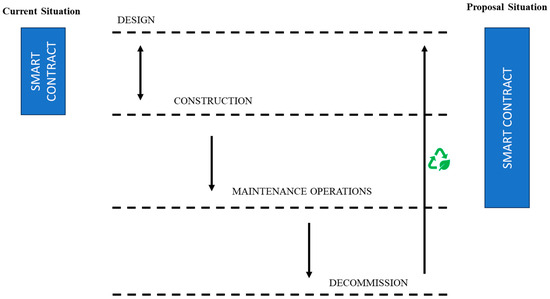
Figure 1.
Current practice vs. proposed improvements.
Further benefits include accelerating payment transactions, reducing emergency reporting times, and automating critical responses. By leveraging data from commercially available IoT sensors [17], the proposed smart contract system enhances automation, reliability, and traceability in infrastructure management, particularly in emergency scenarios.
This approach enables continuous structural monitoring and, in the event of disasters, automatically triggers essential safety operations, such as mobilizing intervention teams. More importantly, it ensures that these interventions occur in an automated and verifiable manner—an essential feature in emergency management—while maintaining full traceability of decisions and fund allocations [18].
To explore these potential applications, this study adopts a conceptual approach, focusing on how smart contracts can enhance infrastructure management. Moreover, as an illustrative case, an emergency scenario in transportation infrastructure is analyzed, where a smart contract—integrated with external oracles (e.g., sensor data)—monitors critical thresholds. If predefined limits are exceeded, the smart contract autonomously executes safety protocols, demonstrating the benefits of automation, reduced response times, and cost efficiency.
The following section provides a comprehensive literature review on smart contracts based on blockchain technology, emphasizing the innovative contributions of this study. Subsequently, the conceptual framework with methodological aspects is introduced, followed by a detailed discussion on its implications and findings. The paper concludes with a summary of key insights and future research directions.
2. Literature Review and Innovative Aspects
Assessing delays and project failures due to non-payments in construction is complex, yet studies confirm the sector’s high vulnerability to insolvency and delays [19,20]. A key factor in preventing these issues is ensuring a steady financial flow for maintenance and risk management. Proper resource management enables contract obligations to be met [21]. Specifically, to address allocation challenges, smart contracts have been introduced in the construction phase.
First introduced by Nick Szabo [22], smart contracts are blockchain-based digital agreements that automate payments or actions upon predefined conditions. These coded instructions facilitate processes like money transfers, asset registration, and notifications [23]. Blockchain technology ensures immutable record-keeping and traceability [24].
Figure 2 outlines the smart contract implementation: IoT sensors collect real-world data, which are processed (e.g., via a digital twin) and immutably stored on the blockchain. The data are then shared with stakeholders through a structured data warehouse, enhancing decision making [25].
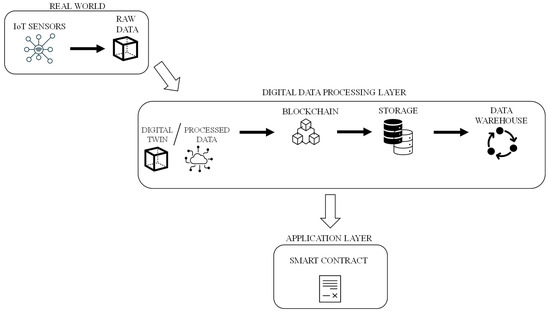
Figure 2.
Flow diagram of the smart contracts’ application from the real word to the digital data processing.
Smart contracts mitigate construction project delays and failures by automating payments and resource transfers [26]. Blockchain’s decentralization and immutability enhance security and transparency, reducing fraud and disputes. The main features are different and varied in nature [27].
Smart contracts offer efficiency and speed in execution. When a condition is met, the associated action is immediately executed, minimizing errors from manual drafting and excluding third part involvement. The blockchain’s immutable ledger guarantees transparency and excludes malicious modifications to previously established terms, ensuring security [28].
For a smart contract to function, an active wallet is required to support its execution; otherwise, payments cannot proceed. However, this relates to legal and regulatory aspects that fall outside the scope of this work [29]. Additionally, smart contracts rely on a blockchain framework to ensure security, traceability, and transparency. Blockchains function as immutable ledgers and can be public (open to all), private (restricted to a company or institution), or hybrid (accessible to specific users) [30,31].
Smart contracts are primarily implemented on private blockchains [31]. Each transaction generates a block containing monitoring data and documentation (Figure 3). This block is verified, linked to the chain, and secured by the blockchain’s structure. Any attempt to alter a block would require modifying the entire chain, ensuring data integrity and security over time [32].

Figure 3.
Blockchain functioning.
Typically, a basic smart contract framework is composed of six different layers:
- Data layer;
- Network layer;
- Consensus layer;
- Incentive layer;
- Smart contract layer;
- DApplication layer.
The data layer manages and stores information, while the network layer enables communication between nodes, utilizing the consensus layer to validate new blocks. A key distinction in blockchain 3.0 systems, such as IOTA, is the evolved incentive layer, which differs from earlier versions focused on financial transactions like Bitcoin [28,29,33,34].
The smart contract layer encodes agreements between parties, with Solidity [35] as the industry-standard language for Ethereum-based contracts [36]. Its flexibility and robustness make it suitable for various contract types [37].
Finally, the DApplication layer (DAPP) provides a user interface to interact with underlying blockchain layers, playing a crucial role in smart contract implementation.
2.1. Smart Contract
It is evident that the capability of a smart contract is largely dependent on the programming language, e.g., Solidity. In the literature, this concept has often been divided into two distinct parts, specifically referring to smart contract code and smart legal contract [38]. The former concerns the coding of information and its interaction with the supporting blockchain infrastructure, specifically referencing actions of data storage, archiving, and verification of conditions. This aspect determines the actual efficiency and effectiveness of a smart contract.
The term smart legal contract refers to the ability of legal and political institutions to implement architectures supporting these technological tools. In this work, the team focused on developing and implementing smart contracts at a technical level. For a smart contract to function correctly, it must be properly programmed, connected to a blockchain infrastructure, and linked to an account [39]. The link between the final user and the blockchain framework is fulfilled by the DAPP, allowing the user to access all functions of the smart contract.
Each smart contract is assigned to a hash function (Figure 3), which is a unique 20-byte address with a cryptographic function to be resolved. Once such an encoded function is resolved, the smart contract receives what is technically referred to as the network’s consensus [40]. As the predefined consensus value is reached, the contract is automatically executed.
There are two main types of smart contracts: deterministic and non-deterministic. The former depends exclusively on the information within the blockchain infrastructure, while the latter require external information provided by “oracles”. This paper specifically focused on using an oracle, a viaduct monitoring system, to provide the necessary information for the smart contract to perform the required maintenance operations [41].
In recent years, the advantages and disadvantages of using smart contracts in the construction industry have been investigated. Table 1 describes the main features of smart contracts and the related benefits they provide [24,33]. It is evident that automation, the ability for certain actions to be executed autonomously and automatically upon the occurrence of specific conditions, does not compromise the capability to track all operations and relevant factors involved. For this reason, one of the major benefits obtained is a reduction in time, and consequently costs, also linked to a decrease in legal disputes.

Table 1.
Characteristics and benefits.
In the literature, several studies address the application and implications of this new tool, which lends itself to various applications in the construction industry. However, these works have primarily investigated and demonstrated the benefits of using smart contracts during the design and construction phases, particularly concerning the management and payment during the procurement of construction materials [3,11,42,43,44], potential design changes, and the payment for various works [45].
In some cases, studies have explored the possibility of using blockchain technology to certify project documents aimed at defining specific project milestones [43,44]. Other applications consider the use of this technology when project documents are subject to modifications due to issues encountered during the design and construction phases [45]. These technical changes have affected the management costs of the construction site and the project itself, including materials and labor [46]. As evidenced by the review studies conducted in recent years, the scientific community’s efforts have primarily focused on resolving issues related to cash flow management, logistics, and automated payment processes [47,48]. On the other hand, it has been noted that the construction sector’s future developments lie in the application of smart contracts to quality management and facility management. For these applications, it has been observed that effective workflows and proper integrations with the various employed technologies still need to be defined [48].
2.2. Innovative Aspects
This paper conceptually explores the advantages and limitations of applying smart contracts in the management and maintenance phases, expanding beyond their use in design and construction. Their application in structural maintenance and emergency management remains largely unexplored. The goal is to reduce response times for maintenance teams while ensuring transparent tracking of interventions and related expenditures.
As shown in the diagram in Figure 4, the smart contract, which is based on blockchain technology, can be utilized in two different ways, making it a flexible tool throughout the life cycle and suitable for both routine maintenance activities, whether ordinary or extraordinary, and in emergency situations.
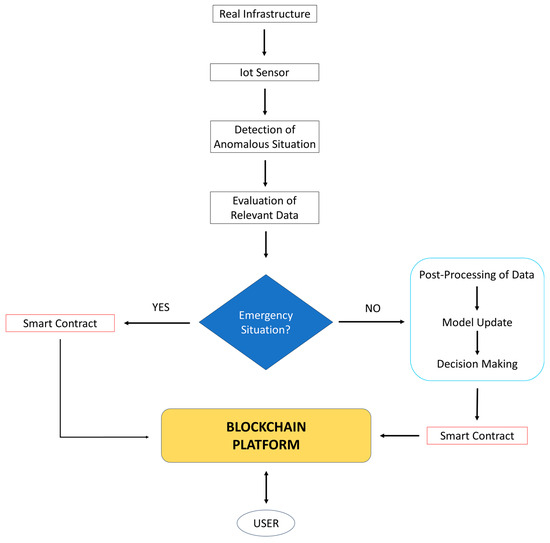
Figure 4.
Smart contract interactions.
The left side of Figure 4 shows that the activation of the smart contract is not influenced by purely human analysis and decision-making processes. It is directly triggered when pre-established conditions occur unless specifically planned actions (e.g., using an operator’s supervision before activating interventions). In this case, sensors, known as external oracles, send measurements directly to the smart contract, which compares the received data with the threshold values set within it. Upon exceeding one or more thresholds, the smart contract automatically activates and executes all the actions specified and encoded in the contract.
The second mode of use, shown on the right side of the diagram, involves constructing the smart contract following a process of analysis, interpretation, and decision making aimed at ensuring optimal solutions for managing the structure. In this case, the encoding of the contract and the actions triggered by specific inputs are not determined by external elements, such as sensors. Actions, for example, may be automatically activated after a certain period of time or upon the completion of planned works through the contract subscription.
The difference between the two solutions lies in the way the smart contract is activated. In the first case, in an emergency state, the contract is activated when thresholds detected by external oracles are exceeded. In the second case, the contract is activated based on factors defined following a data analysis and interpretation.
Another difference is the timing of when the two contracts are established: the first is built alongside the monitoring system, while the second is constructed based on data that have been processed later.
Smart contracts introduce a paradigm shift in asset management, offering distinct advantages over traditional methods by enhancing automation, information tracking, and data certification. While they have been widely used in construction for material tracking and payment automation, this study explores their application in real-time emergency management and maintenance operations, addressing a significant gap in the literature.
This research proposes a novel flowchart for integrating smart contracts into management and emergency procedures, ensuring a structured, automated, and verifiable approach to infrastructure resilience. In this context, “emergency” refers to critical situations where human safety is at risk—such as when a monitored facility no longer meets ultimate state limit (USL) conditions.
The core innovation lies in how smart contracts impact two fundamental aspects:
- Automation: By enabling pre-programmed responses, smart contracts drastically reduce intervention times, minimizing downtime and enhancing system resilience. This contrasts with conventional decision-making processes, which rely heavily on manual assessments and procedural delays.
- Information tracking and validation: Every intervention and decision-making phase is immutably recorded, ensuring transparency and accountability. This extends beyond financial transactions to certify compliance with contractual obligations, safety protocols, and prescribed maintenance guidelines.
Unlike traditional applications focused on payment security and material certification, this study illustrates how smart contracts can serve as a governance tool for emergency response and infrastructure oversight. The ability to track and validate decisions ensures legal enforceability, facilitates responsibility attribution, and supports post-event audits.
However, human oversight remains essential to guarantee quality control and compliance. Financial operations are safeguarded through pre-allocated funds and verification mechanisms, ensuring payments are executed only after approval from qualified technicians.
As explored in this study, this approach has the potential to significantly reduce downtime and enhance the legal certification of responsibilities during emergency events, marking an advancement in the use of blockchain for infrastructure management.
3. Conceptual Framework and Methodological Aspects
The simulated scenario involved creating a smart contract programmed to react when a predetermined threshold is exceeded, as detected by an external oracle. The smart contract is written using the Solidity programming language, which is developed to operate on the Ethereum blockchain infrastructure, using the cryptocurrency Ether for payments [49,50]. The choice of Ethereum was made considering that this platform is one of the most popular and widely used in the world, as well as being the first to introduce smart contracts. Additionally, Solidity was selected because it offers various functionalities that enhance security and interoperability with different Ethereum standards, making it easily integrable into Dapps [51].
Once written, the code, within a file with the .sol extension, is compiled to generate bytecode, which is then distributed on the blockchain, making the contract operational. The monitoring system, composed of IoT sensors [52], and supported by low latency 5G technology [53], enables near real-time monitoring, acquiring values that are compared with the thresholds established during the design phase of the structure. This monitoring system thus acts as an external oracle, a source of data external to the contract but on which some of the smart contract’s actions depend [54,55]. The internal code of the smart contract can be developed [56]. As described, the input data consist of the values detected by the monitoring system. If these values exceed the set thresholds, the smart contract automatically activates its functions.
The simulated scenario represents an emergency condition, detected by the IoT monitoring system, where the primary priority is the protection of human life.
In this scenario, the emergency is triggered by the hypothetical exceeding of predefined threshold values for one of the parameters measured by the monitoring system. However, this study does not examine specific threshold values; the parameters that led to the emergency; or the most suitable communication protocol for IoT sensors, which may use MQTT, CoAP, or HTTP. These aspects are case-specific and fall outside the scope of the conducted simulation.
Rather, the primary objective of this scenario is to verify the correct reception of the alarm signal, which activates the smart contract and triggers the corresponding automated operations. When the thresholds are exceeded, the smart contract executes three distinct actions, which, as previously mentioned, are carried out autonomously and automatically.
The first action involves sending an alert notification to the maintenance and control teams, who are tasked with verifying whether the alarm is real or a false positive. Indeed, the asset owner has a contractor team from outside or internally that begin operations (e.g., restoration processes with interventions) once an alert is confirmed. The second action is the saving of relevant information at both a technical and legal level, such as the ID of the sensor(s) that reported the threshold overcoming, the time and date of the occurrence, and the responsible operator present during that specific situation. The third and final action involves sending a signal that leads to the closure of a section or the entire infrastructure, based on the risk management plan.
The various types of interventions and their associated costs are pre-determined when the contract is being coded, similar to a paper contract. Once the restoration work is completed, the responsible party conducts a quality check, and if passed, they approve the intervention. With the approval of the intervention, and the simultaneous uploading of post-intervention evidence documentation, the work is certified as meeting the performance requirements outlined by current regulations and agreed upon during the contract definition. Upon receiving confirmation from the responsible party, the work carried out is verified, and the contract proceeds with the immediate payment of the completed work. Figure 5 summarizes the logical flow of the smart contract definition and operation, and it will be further detailed in the forthcoming sections.
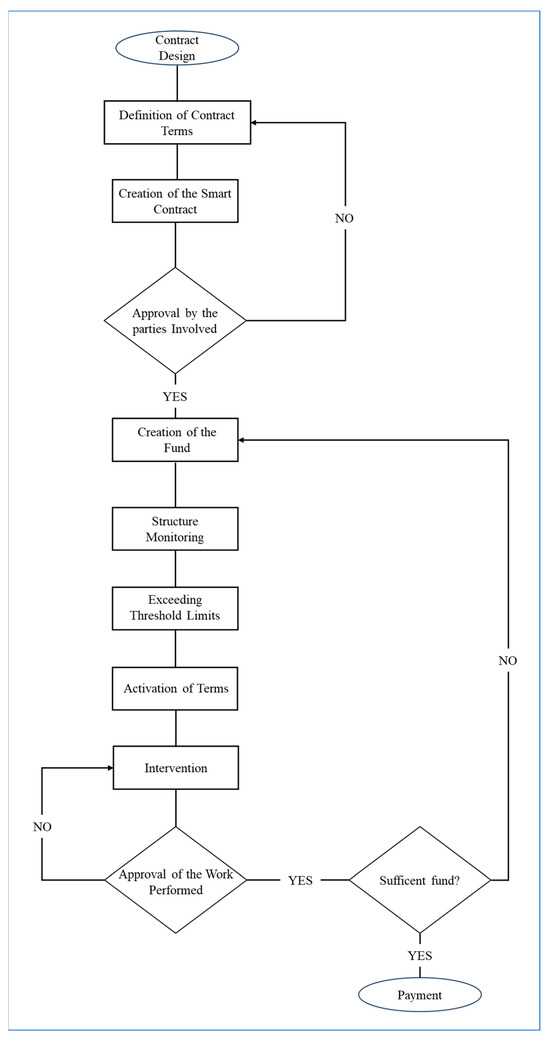
Figure 5.
Smart contract flowchart.
Description of the Structure
The contract, named “EmergencyManagement”, consists of several functions that represent the actions previously described. The program’s architecture is composed of the following main actions. The programming language employed for code development is Solidity. The code was structured through functions, enabling the creation of a solution that is both user-friendly and adaptable to diverse scenarios. It should be noted that each action in a smart contract incurs a cost measured in the unit known as gas [57]. The more complex the code, the higher the overall cost of the operation for the end user. (i) The contract’s structure is designed by defining a set of information relevant to the emergency, including the sensor ID, the time and date of the event, and the details of the responsible parties involved. (ii) To ensure a high level of security, especially in the event of legal disputes, the “owner” field is introduced, which stores the contract owner. The owner is the only one allowed to modify and execute the main functions, such as entering the amounts for different works, assigning team names, and authorizing payments. (iii) As shown in the diagram representing the contract’s logical flow (Figure 5), once the threshold limit is exceeded, the contract is activated. (iv) In addition to updating the number of reports, an event called “EmergencyReported” is created, which notifies predefined recipients of the contract’s activation and the triggering cause of the emergency. Within this framework, every intervention and risk is assigned a unique ID, thereby facilitating the unambiguous identification of each event. (v) A notification is sent to request the intervention of the designated team, which will use the “confirmRisk” function to confirm or refute the validity of the situation detected by the sensors (Figure 6). The “confirmRisk” function also requires the upload of evidence documentation to certify the basis on which decisions are made to confirm the reported situation.
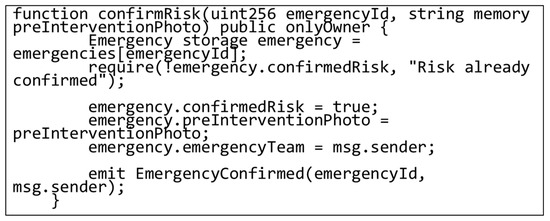
Figure 6.
Pseudo Code, in Solidity, confirmRisk function.
Once the intervention operations are completed, the team, using the “resolveEmergency” function (Figure 7) can declare the completion of the work and upload post-intervention images. These images, like the pre-intervention ones, are not managed within the contract but are stored on InterPlanetary File System (IPFS), which will provide a unique hash. IPFS assures that the data included in the network are unique and are protected against modifications, making these data immutable. This operation is therefore not managed by the smart contract itself but by the DApp on which it runs.
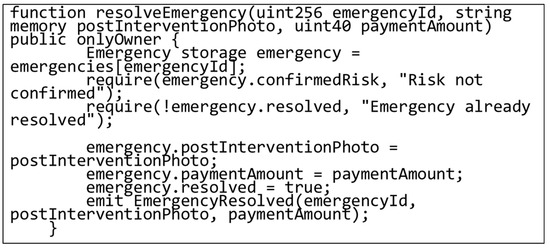
Figure 7.
Pseudo Code, in Solidity, resolveEmergency function.
The DApp is simply an application that provides a user-friendly graphical interface for the end user. The payment for completed works is executed through the “makePayment” function. This function, of which an example code is shown in Figure 8, ensures that the specified payment fund contains the requested amount and then processes the payment instantly and automatically upon contract completion.
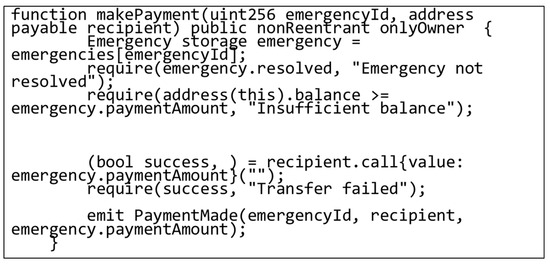
Figure 8.
Pseudo Code, in Solidity makePayment function.
4. Results and Discussions
The proposed solution provides significant advantages, particularly in enhancing the system’s rapid response capability through smart contracts. Integrated with IoT sensors, the contract facilitates an immediate and automated response to potential risks. Current monitoring systems, already widely used to control access to sensitive infrastructures like bridges or tunnels, are generally limited to blocking individual nodes. In contrast, a smart contract could extend closure to multiple consecutive nodes, and based on the closure time, local administrations could receive compensation calculated on the hidden costs generated by the infrastructure’s inactivity.
By using a properly designed monitoring system and a digital twin, representing the territory and the infrastructure network, it is possible to use the smart contracts to ensure safety and timely response in emergency situations in order to improve the community resilience. For instance, a flood detected upstream could pose a risk to several downstream bridges [58]. With a smart contract, as soon as the monitoring system detects the critical event, the affected bridges would automatically be closed to traffic. Once the emergency signal ceases, the system would automatically calculate the economic damage incurred and proceed with immediate payment, with further physical damage assessment based on the interventions carried out by the teams. The contract, built with a dual verification system, ensures compliance with the pre-agreed and designed procedures for managing various risk scenarios, balancing automation with human oversight. This not only ensures the correct execution of operations but also adherence to the expected timelines.
Adopting a smart contract improves emergency response and ensures that management operations are carried out in the correct order and manner, simultaneously reducing potential legal disputes that often follow critical events. The planned interventions outlined in the safety plan are faithfully executed since they are predefined and encoded within the contract itself. This logic also applies to ordinary and extraordinary maintenance, where activation is not triggered by a critical event but by a scheduled timeline based on performance degradation analysis over time. Legally, the smart contract serves as the ideal tool to bridge the gap between the rapid response required in risk management and the legal frameworks governing the sector [59].
The smart contract also includes the possibility of uploading evidence documentation to report the damage and the post-intervention situation, a solution that addresses transparency regarding intervention methods and material use. The documentation (e.g., images), stored on blockchain, combined with the verification by the responsible party, provide the necessary flexibility in managing these situations, which inherently involve a degree of unpredictability.
For these reasons, the functionality of the smart contract was verified using the written code efficiency verification tool SolidityScan [60]. This tool allows the functionality and efficiency of the code to be highlighted with a score from 0 to 100 points. The created code obtained a score of 86.75, with no critical issues.
As can be seen from Figure 9, the code has an excellent functioning capacity. The information in the gas is essentially due to the authors’ choice to connect external information to the smart contract that cannot be easily codified, such as photographs. Indeed, photographs will have a different weight based on their quality and quantity, thus modifying the gas required for the use of the smart contract. The aspect of gas is still critical today for the development of smart contracts.

Figure 9.
Code score.
Several studies [61] highlight that maintenance and disaster response interventions frequently experience delays due to bureaucratic inefficiencies, payment processing issues, and poor coordination among stakeholders. These inefficiencies can trigger cascading delays, exacerbating infrastructure deterioration and increasing overall costs. Previous research has explored various solutions, such as streamlining approval workflows and enhancing financial governance; however, these approaches often remain human-dependent and prone to administrative bottlenecks.
In contrast, the adoption of smart contracts addresses these challenges by automating key processes, particularly payment execution, based on predefined contractual conditions. This reduces reliance on intermediaries, minimizes procedural uncertainties, and fosters trust among stakeholders by ensuring that payments are executed transparently and in a timely manner. Compared to traditional contract management methods, smart contracts offer a self-executing mechanism that significantly improves the efficiency and accountability of financial transactions in infrastructure maintenance and emergency scenarios.
Governance in infrastructure management involves administrative and bureaucratic actions related to process transparency, procurement, and role coordination. Studies [62] highlight that inefficiencies in these areas cause delays, cost overruns, and reduced operational efficiency.
Smart contracts streamline these processes by automating contract execution and compliance monitoring, eliminating uncertainties and discretionary delays. Unlike traditional systems, they self-execute based on predefined conditions, reducing both direct and indirect costs. This automation accelerates decision making, benefiting both routine maintenance and risk management operations [63].
The effectiveness of these plans is evaluated using key performance indicators (KPIs), shown in Figure 10 [62,63,64,65], which clearly benefit from the automation and autonomy provided by smart contracts. The cost performance index (CPI), a key metric for budget deviation, highlights how governance inefficiencies—such as funding delays, permit approvals, and certification processes—negatively impact overall costs. By streamlining these aspects, smart contracts enhance financial predictability and operational efficiency.
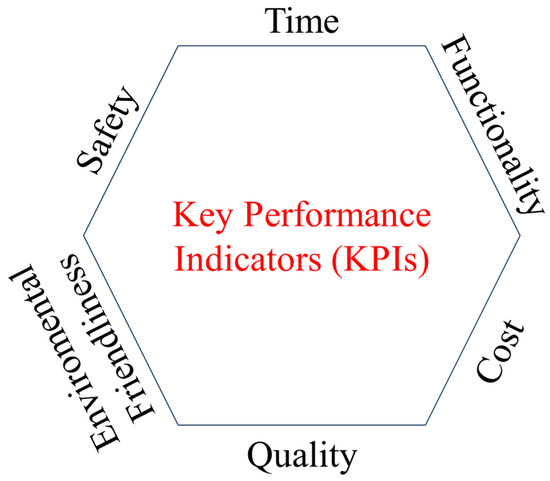
Figure 10.
Key performance indicators.
Figure 11 compares the planned budget trend for an emergency intervention with and without smart contracts. In a scenario where an extreme flood impacts multiple bridges along a watercourse, the event would trigger an emergency response phase, potentially leading to severe infrastructure damage.
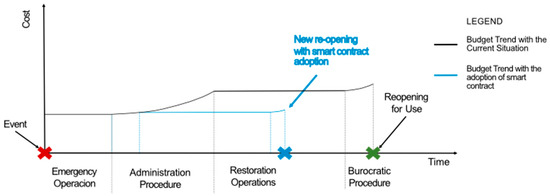
Figure 11.
Diagram representing budget increase requests.
In the current situation, once the critical event is managed, authorities must assess damage, allocate funds, and initiate restoration to meet safety and efficiency standards before reopening. This administration procedure often faces delays due to funding availability, bureaucratic approvals, and poor interdepartmental communication. Once work is completed, the bureaucratic procedure follows, but inefficiencies such as stakeholder misalignment and disorganized workflows can further slow the process.
By integrating smart contracts, these administrative and bureaucratic steps can be significantly streamlined, reducing delays and improving budget adherence. However, two key aspects remain: (1) operational phases (emergency response and restoration) are assumed to follow pre-established timelines, and (2) human oversight remains essential to prevent errors, such as false positives or misinterpretations of automated signals. Contrary to concerns about full automation, smart contracts shorten but do not eliminate administrative and bureaucratic phases, ensuring both efficiency and control.
As shown in Figure 12, and supported by the literature, many restoration delays are due to administrative and bureaucratic issues, such as delays in inspections required for reopening [66,67].
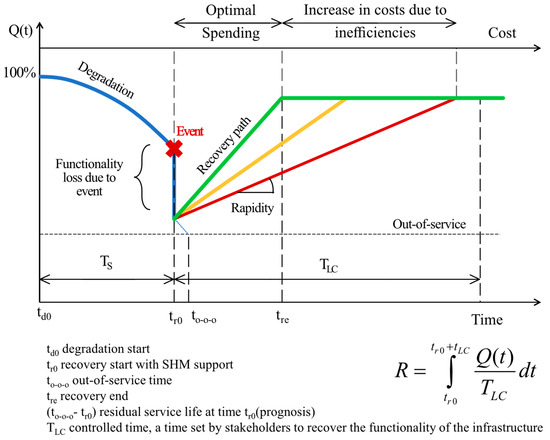
Figure 12.
Resilience function.
The graph in Figure 12 shows the trend of infrastructure functionality function over time and following a critical event, such as an earthquake or a flood. The inclined lines from tr0 represent the recovery paths to restore operability. The green line indicates the improved recovery path, which is also linked to the optimal expenditure costs for the various operations. The two lines, one orange and one red, represent less effective recovery paths that have experienced time delays due to administrative or bureaucratic issues, leading to an increase in costs.
It is worth noticing how the resilience R of an infrastructure is defined by the area under the recovery line and the subsequent horizontal line [66] within the controlled time span TLC; the longer the recovery operations take, the lower the resilience. It follows that lower resilience is influenced by increased recovery time and inefficient operations. In this sense, smart contracts could help to streamline and accelerate the processes necessary for complete recovery, such as the transfer of documents needed for testing and inspections.
The CPM (critical path method) chart in Figure 13 illustrates how extending project timelines beyond the optimal duration increases total costs, primarily due to inefficiencies in traditional legal contracts and bureaucratic interactions [68,69,70].
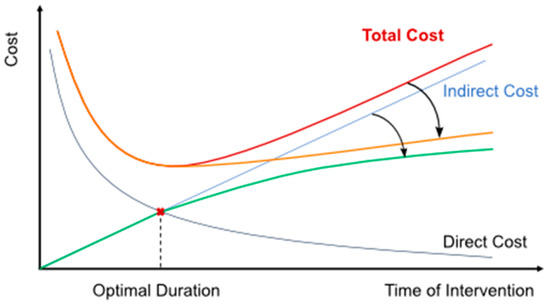
Figure 13.
CPM costs and optimal project duration.
Smart contracts mitigate these inefficiencies by reducing indirect costs, as shown by the green curve in Figure 13. This cost reduction stems from improved process efficiency, faster approvals, and streamlined administrative workflows. Consequently, the direct cost curve also shifts downward when project durations exceed optimal timelines, as illustrated by the orange line, due to the cascading effects of lower indirect costs.
Future research will focus on quantifying these cost variations, refining the model with empirical data to enhance the accuracy of cost-performance curves.
Finally, it is also worth noting how the adoption of smart contracts also presents infrastructural and operational challenges. A suitably designed support infrastructure, compatible with 5G technology, is essential to fully leverage the potential of real-time data acquisition from monitoring systems. Additionally, adapting current emergency management and maintenance procedures is necessary to ensure seamless integration. At present, not all administrative entities are sufficiently prepared to support such advancements, and widespread adoption will depend on the sector’s ability to identify a blockchain infrastructure tailored to the specific needs of the construction industry.
5. Conclusions
Smart contracts, along with the underlying blockchain technology, are relatively emerging tools with a wide range of potential applications. Although these technologies have been known and used for some time in the construction phase of projects, their application in the management and maintenance of infrastructure assets has remained limited and largely unexplored. This study specifically addresses this gap, where its innovative contribution lies. By conceptually exploring the use of smart contracts throughout the entire lifecycle of an asset, this work demonstrates how they can offer substantial benefits.
Notably, it has been shown that the automation inherent in these tools can reduce reaction and intervention times in emergency situations; streamline decision-making processes; and accelerate maintenance workflows, whether routine or extraordinary. The efficiency gained in these processes leads to cost optimization, a reduction in administrative and legal disputes, and an opportunity to enhance risk management strategies and facility management practices. Moreover, the transparency and immutability of blockchain foster greater trust among stakeholders by ensuring compliance with predefined operational protocols.
Despite these advantages, several challenges remain unexplored. The widespread adoption of smart contracts in asset management requires addressing regulatory concerns, technical interoperability, and initial investment costs. Additionally, operational risks related to smart contract execution, such as coding errors or vulnerabilities, must be carefully mitigated through rigorous validation and auditing processes.
Therefore, this study adopts a conceptual perspective, exploring the novel application of existing technologies—specifically smart contracts—in the context of infrastructure management and emergency response protocols. The findings suggest that repurposing smart contracts for these critical functions has the potential to enhance infrastructure resilience, operational efficiency, and risk mitigation strategies.
Future research directions include the development and validation of a simulated infrastructure system integrating smart contracts to move towards real-world applications. Further exploration of synergies with artificial intelligence and data-driven approaches is also envisioned. For instance, a promising avenue is the combination of digital twins and smart contracts to enable predictive maintenance, thereby further enhancing the resilience of infrastructure.
Author Contributions
Conceptualization, V.V., M.D. and N.C.; methodology, V.V., L.G., M.D. and N.C.; software, L.G.; validation, L.G.; formal analysis, V.V., L.G., M.D. and N.C.; resources, V.V., L.G., M.D. and N.C.; data curation, V.V., L.G., M.D. and N.C.; writing—original draft preparation, L.G. and M.D; writing—review and editing, L.G. and M.D.; visualization, L.G.; supervision, V.V., M.D. and N.C.; project administration, V.V., M.D. and N.C. All authors have read and agreed to the published version of the manuscript.
Funding
This research received no external funding.
Data Availability Statement
The data presented in this study are available on request from the corresponding author.
Conflicts of Interest
The authors declare no conflict of interest.
References
- Rathorea, M.M.; Ahmada, A.; Paul, A.; Rho, S. Urban planning and building smart cities based on the Internet of Things using Big Data analytics. Comput. Netw. 2016, 101, 63–80, ISSN 1389-1286. [Google Scholar] [CrossRef]
- Jiang, D. The construction of smart city information system based on the Internet of Things and cloud computing. Comput. Commun. 2020, 150, 158–166, ISSN 0140-3664. [Google Scholar] [CrossRef]
- Global Construction Perspectives and Oxford Economics. A Global Forecast for the Construction Industry by 2030; Global Construction Perspectives and Oxford Economics: London, UK, 2015; ISBN 978-0-9564207-9-4. [Google Scholar]
- Ramachandra, T.; Rotimi, J.O.B. Mitigating payment problems in the construction industry through analysis of construction payment disputes. J. Leg. Aff. Disput. Resolut. Eng. Constr. 2014, 7, A4514005. [Google Scholar] [CrossRef]
- Ahmadisheykhsarmast, S.; Sonmez, R. A smart contract system for security of payment of construction contracts. Autom. Constr. 2020, 20, 103401. [Google Scholar]
- Liu, J.; Li, H.; Skitmore, M.; Zhang, Y. Experience mining based on case-based reasoningfor dispute settlement of international construction projects. Autom. Constr. 2019, 97, 181–191. [Google Scholar] [CrossRef]
- Tran, H.; Carmichael, D.G. Contractor’s financial estimation based on owner payment histories. Int. J. Organ. Technol. Manag. Constr. 2012, 4, 481–489. [Google Scholar] [CrossRef][Green Version]
- Das, M.; Luo, H.; Cheng, J.C.P. Securing interim payments in construction projects through a blockchain-based framework. Autom. Constr. 2020, 118, 103284. [Google Scholar] [CrossRef]
- Perera, S.; Nanayakkara, S.; Rodrigo, M.N.N.; Senaratne, S.; Weinand, R. Blockchain technology: Is it hype or real in the construction industry? J. Ind. Inf. Integr. 2020, 17, 100125. [Google Scholar] [CrossRef]
- Ye, X.; Zeng, N.; König, M. Systematic literature review on smart contracts in the construction industry: Potentials, benefits, and challenges. Front. Eng. Manag. 2022, 9, 196–213. [Google Scholar] [CrossRef]
- Kim, M.; Kim, Y.W. Applications of blockchain for construction project procurement. Autom. Constr. 2024, 165, 105550. [Google Scholar] [CrossRef]
- Ahmadisheykhsarmast, S.; Golmohammadi Senji, S.; Sonmez, R. Decentralized tendering of construction projects using blockchain-based smart contracts and storage systems. Autom. Constr. 2023, 151, 104900. [Google Scholar] [CrossRef]
- Sonmez, R.; Ahmadisheykhsarmast, S.; Akçamete Güngör, A. BIM integrated smart contract for construction project progress payment administration. Autom. Constr. 2022, 139, 104294. [Google Scholar] [CrossRef]
- Wu, L.; Lu, W.; Xu, J. Blockchain-based smart contract for smart payment in construction: A focus on the payment freezing and disbursement cycle. Front. Eng. Manag. 2022, 9, 177–195. [Google Scholar] [CrossRef]
- Chen, G.; Li, H.; Liu, M.; Hsiang, S.M.; Jarvamardi, A. Knowing what is going on—A smart contract for modular construction. Can. J. Civ. Eng. 2023, 50, 210–223. [Google Scholar] [CrossRef]
- Chen, G.; Liu, M.; Li, H.; Hsiang, S.M.; Jarvamardi, A. Motivating Reliable Collaboration for Modular Construction: Shapley Value–Based Smart Contract. J. Manag. Eng. 2023, 39, 04023042. [Google Scholar] [CrossRef]
- Plageras, A.P.; Psannis, K.E.; Stergiou, C.; Wang, H.; Gupta, B.B. Efficient IoT-based sensor BIG Data collection–processing and analysis in smart buildings. Future Gener. Comput. Syst. 2018, 82, 349–357, ISSN 0167-739X. [Google Scholar] [CrossRef]
- Pohl, D.; Bouchachia, A.; Hellwagner, H. Automatic Identification of Crisis-Related Sub-events Using Clustering. In Proceedings of the 2012 11th International Conference on Machine Learning and Applications, Boca Raton, FL, USA, 12–15 December 2012; pp. 333–338. [Google Scholar] [CrossRef]
- Murray, J. Review of Security of Payment Laws: Building Trust and Harmony; Department of Jobs and Small Business: Canberra, Australian, 2017. Available online: https://www.sasbc.sa.gov.au/pdfs/Murray-Review.pdf (accessed on 29 May 2024).
- Kenney, R.; La Cava, G.; Rodgers, D. Why Do Companies Fail? Reserve Bank of Australia: Perth, Australia, 2016. Available online: https://www.rba.gov.au/publications/rdp/2016/pdf/rdp2016-09.pdf (accessed on 29 May 2024).
- Fiocco, J. Final Report to the Minister for Commerce: Security of Payment Reform in the WA Building and Construction Industry; The Department of Mines, Industry Regulation and Safety–Building and Energy Division: East Perth, Australia, 2018. Available online: https://www.commerce.wa.gov.au/sites/default/files/atoms/files/final_report_-_security_of_payment_reform_in_the_wa_building_and_construction_industry.pdf (accessed on 29 May 2024).
- Szabo, N. Formalizing and Securing Relationships on Public Networks. Available online: https://www.fon.hum.uva.nl/rob/Courses/InformationInSpeech/CDROM/Literature/LOTwinterschool2006/szabo.best.vwh.net/smart_contracts_2.html (accessed on 29 May 2024).
- Savelyev, A. Contract law 2.0: ‘Smart’contracts as the beginning of the end of classic contract law. Inf. Commun. Technol. Law 2017, 26, 116–134. [Google Scholar] [CrossRef]
- Ølnes, S.; Ubacht, J.; Janssen, M. Blockchain in government: Benefits and implications of distributed ledger technology for information sharing. Gov. Inf. Q. 2017, 34, 355–364. [Google Scholar] [CrossRef]
- Janssen, M.; Van Der Voort, H.; Wahyudi, A. Factors influencing big data decision-making quality. J. Bus. Res. 2017, 70, 338–345. [Google Scholar] [CrossRef]
- Hamledari, H.; Fischer, M. Construction payment automation using blockchain-enabled smart contracts and robotic reality capture technologies. Autom. Constr. 2021, 132, 103926. [Google Scholar] [CrossRef]
- Wang, S.; Yuan, Y.; Wang, X.; Li, J.; Qin, R.; Wang, F.-Y. An Overview of Smart Contract: Architecture, Applications, and Future Trends. In Proceedings of the 2018 IEEE Intelligent Vehicles Symposium (IV), Changshu, China, 26–30 June 2018; pp. 108–113. [Google Scholar] [CrossRef]
- Swan, M. Blockchain: Blueprint for a New Economy; O’Reilly Media: Sebastopol, CA, USA, 2015. [Google Scholar]
- Levi, S.D.; Lipton, A.B. An Introduction to Smart Contracts and Their Potential and Inherent Limitations. 2018. Available online: https://corpgov.law.harvard.edu/2018/05/26/an-introduction-to-smart-contracts-and-their-potential-and-inherent-limitations/ (accessed on 29 May 2024).
- Yang, R.; Wakefield, R.; Lyu, S.; Jayasuriya, S.; Han, F.; Yi, X.; Yang, X.; Amarasinghe, G.; Chen, S. Public and private blockchain in construction business process and information integration. Autom. Constr. 2020, 118, 103276, ISSN 0926-5805. [Google Scholar] [CrossRef]
- Lai, R.; Chuen, D.L.K. Chapter 7—Blockchain—From Public to Private. In Handbook of Blockchain, Digital Finance, and Inclusion; Chuen, D.L.K., Deng, R., Eds.; Academic Pres: Cambridge, MA, USA, 2018; Volume 2, pp. 145–177. ISBN 9780128122822. [Google Scholar] [CrossRef]
- Pilkington, M. Chapter 11: Blockchain technology: Principles and applications. In Research Handbook on Digital Transformations; Edward Elgar Publishing: Cheltenham, UK, 2016. [Google Scholar] [CrossRef]
- Nzuva, S.M. Smart Contracts Implementation, Applications, Benefits, and Limitations. J. Inf. Eng. Appl. 2019. [Google Scholar] [CrossRef]
- IOTA. Available online: https://www.iota.org/ (accessed on 29 May 2024).
- Dannen, C. Introducing Ethereum and Solidity; Apress: Berkeley, CA, USA, 2017; Volume 1, pp. 159–160. [Google Scholar]
- Mukhopadhyay, M. Ethereum Smart Contract Development: Build Blockchain-Based Decentralized Applications Using Solidity; Packt Publishing Ltd.: Birmingham, UK, 2018. [Google Scholar]
- Wohrer, M.; Zdun, U. Smart contracts: Security patterns in the ethereum ecosystem and solidity. In Proceedings of the 2018 International Workshop on Blockchain Oriented Software Engineering (IWBOSE), Campobasso, Italy, 20 March 2018; pp. 2–8. [Google Scholar]
- Stark, J. Making Sense of Blockchain Smart Contracts. Available online: https://www.coindesk.com/markets/2016/06/04/making-sense-of-blockchain-smart-contracts (accessed on 29 May 2024).
- Alharby, M.; van Moorsel, A. Blockchain Based Smart Contracts: A Systematic Mapping Study. In Computer Science & Information Technology (CS & IT); Academy & Industry Research Collaboration Center (AIRCC): Piscataway, NJ, USA, 2017. [Google Scholar] [CrossRef]
- Liu, C.; Chai, K.K.; Zhang, X.; Chen, Y. Peer-to-peer electricity trading system: Smart contracts based proof-of-benefit consensus protocol. Wirel. Netw. 2021, 27, 4217–4228. [Google Scholar] [CrossRef]
- Morabito, V. Smart contracts and licensing. In Business Innovation Through Blockchain; Springer: Berlin/Heidelberg, Germany, 2017; pp. 101–124. [Google Scholar]
- Li, J.; Kassem, M. Applications of distributed ledger technology (DLT) and Blockchain-enabled smart contracts in construction. Autom. Constr. 2021, 132, 103955, ISSN 0926-5805. [Google Scholar] [CrossRef]
- Shojaei, A.; Flood, I.; Moud, H.I.; Hatami, M.; Zhang, X. An Implementation of Smart Contracts by Integrating BIM and Blockchain. In Proceedings of the Future Technologies Conference (FTC), San Francisco, CA, USA, 24–25 October 2019; Springer: Cham, Switzerland, 2019; pp. 519–527. [Google Scholar] [CrossRef]
- Li, J.; Kassem, M. A Proposed Approach Integrating DLT, BIM, IoT and Smart Contracts: Demonstration Using a Simulated Installation Task. In Proceedings of the International Conference on Smart Infrastructure and Construction 2019 (ICSIC), Cambridge, UK, 8–10 July 2019; pp. 275–282. [Google Scholar] [CrossRef]
- Luo, H.; Das, M.; Wang, J.; Cheng, J.C.P. Construction payment automation through smart contract-based blockchain framework. In Proceedings of the 36th International Symposium on Automation and Robotics in Construction, ISARC 2019, Banff, AB, Canada, 21–24 May 2019; pp. 1254–1260. [Google Scholar] [CrossRef]
- Sheng, D.; Lou, H.; Zhong, B. Formal modeling of smart contracts for quality acceptance in construction. In Proceedings of the Creative Construction EConference 2020, Online, 28 June–1 July 2020; Budapest University of Technology and Economics: Budapest, Hungary, 2020; pp. 79–87. [Google Scholar] [CrossRef]
- Rathnayake, I.; Wedawatta, G.; Tezel, A. Smart contracts in the construction industry: A systematic review. Buildings 2022, 12, 2082. [Google Scholar] [CrossRef]
- Yu, H.; Deng, X.; Zhang, N.; Zhang, X. Is blockchain cost-effective in construction project management? A systematic review from the perspective of transaction cost. Eng. Constr. Archit. Manag. 2024. [Google Scholar] [CrossRef]
- Chong, H.-Y.; Diamantopoulos, A. Integrating advanced technologies to uphold security of payment: Data flow diagram. Autom. Constr. 2020, 114, 103158, ISSN 0926-5805. [Google Scholar] [CrossRef]
- Zhang, W.; Anand, T. Blockchain and Ethereum Smart Contract Solution Development. In Dapp Programming with Solidity; Apress Media LCC: New York, NY, USA, 2022. [Google Scholar] [CrossRef]
- Ghazizadeh, E.; Sun, T. A Systematic Literature Review of Smart Contract Applications. In Proceedings of the Future Technologies Conference (FTC) 2020, Volume 3, FTC 2020, Vancouver, BC, Canada, 5–6 November 2020; Advances in Intelligent Systems and Computing. Arai, K., Kapoor, S., Bhatia, R., Eds.; Springer: Cham, Switzerland, 2021; Volume 1290. [Google Scholar] [CrossRef]
- Mishra, M.; Lourenço, P.B.; Ramana, G.V. Structural health monitoring of civil engineering structures by using the internet of things: A review. J. Build. Eng. 2022, 48, 103954, ISSN 2352-7102. [Google Scholar] [CrossRef]
- Bahalul Haque, A.K.M.; Oahiduzzaman Mondol Zihad, M.; Rifat Hasan, M. 5G and Internet of Things—Integration Trends, Opportunities, and Future Research Avenues. In 5G and Beyond; Bhushan, B., Sharma, S.K., Kumar, R., Priyadarshini, I., Eds.; Springer Tracts in Electrical and Electronics Engineering; Springer: Singapore, 2023. [Google Scholar] [CrossRef]
- Caldarelli, G. Understanding the Blockchain Oracle Problem: A Call for Action. Information 2020, 11, 509. [Google Scholar] [CrossRef]
- Curran, B. What Are Oracles? Smart Contracts, Chainlink & The Oracle Problem. Available online: https://blockonomi.com/oracles-guide (accessed on 11 August 2024).
- Wang, S.; Ouyang, L.; Yuan, Y.; Ni, X.; Han, X.; Wang, F.Y. Blockchain-Enabled Smart Contracts: Architecture, Applications, and Future Trends. IEEE Trans. Syst. Man Cybern. Syst. 2019, 49, 2266–2277. [Google Scholar] [CrossRef]
- Albert, E.; Correas, J.; Gordillo, P.; Román-Díez, G.; Rubio, A. Gasol: Gas analysis and optimization for ethereum smart contracts. In Proceedings of the International Conference on Tools and Algorithms for the Construction and Analysis of Systems, Dublin, Ireland, 25–30 April 2020; Springer International Publishing: Cham, Switzerland, 2020. [Google Scholar]
- Brocca, L.; Barbetta, S.; Camici, S.; Ciabatta, L.; Dari, J.; Filippucci, P.; Massari, C.; Modanesi, S.; Tarpanelli, A.; Bonaccorsi, B.; et al. A Digital Twin of the terrestrial water cycle: A glimpse into the future through high-resolution Earth observations. Front. Sci. 2024, 1, 1190191. [Google Scholar] [CrossRef]
- Turner, B. The smarts of “smart contracts”: Risk management capabilities and applications of self-executing agreements. ANU J. Law Technol. 2021, 2, 89–117. [Google Scholar]
- Mekkouri, M.; Hennebert, C. Practices for Assessing the Security Level of Solidity Smart Contracts. In Proceedings of the International Symposium on Foundations and Practice of Security, Bordeaux, France, 11–13 December 2023; Springer Nature Switzerland: Cham, Switzerland, 2023. [Google Scholar]
- Love, P.E.D.; Sing, M.C.P.; Ika, L.A. Sidney Newton, The cost performance of transportation projects: The fallacy of the Planning Fallacy account. Transp. Res. Part A Policy Pract. 2019, 122, 1–20, ISSN 0965-8564. [Google Scholar] [CrossRef]
- Lam, E.; Chan, A.; Chan, D.D. Benchmarking success of building maintenance projects. Facilities 2010, 28, 290–305. [Google Scholar] [CrossRef]
- Galar, D.; Sandborn, P.; Kumar, U. Maintenance Costs and Life Cycle Cost Analysis, 1st ed.; CRC Press: Boca Raton, FL, USA, 2017. [Google Scholar] [CrossRef]
- Islam, R.; Nazifa, T.H.; Mohamed, S.F. Factors influencing facilities management cost performance in building projects. J. Perform. Constr. Facil. 2019, 33, 04019036. Available online: https://ascelibrary.org/doi/abs/10.1061/%28ASCE%29CF.1943-5509.0001284 (accessed on 29 May 2024).
- Botero Botero, L.F.; Álvarez Villa, M.E. Guía De Mejoramiento Continuo Para La Productividad En La construcción De Proyectos De Vivienda (Lean Construction Como Estrategia De Mejoramiento). Rev. Univ. EAFIT 2012, 40, 50–64. Available online: https://publicaciones.eafit.edu.co/index.php/revista-universidad-eafit/article/view/864 (accessed on 29 May 2024).
- Domaneschi, M.; Cucuzza, R.; Martinelli, L.; Noori, M. Service-life extension of transport infrastructure through structural health monitoring. In Life-Cycle of Structures and Infrastructure Systems; CRC Press: Boca Raton, FL, USA, 2023; pp. 4131–4138. [Google Scholar]
- Domaneschi, M.; Cucuzza, R.; Martinelli, L.; Noori, M.; Marano, G.C. A probabilistic framework for the resilience assessment of transport infrastructure systems via structural health monitoring and control based on a cost function approach. Struct. Infrastruct. Eng. 2024, 1, 1–13. [Google Scholar] [CrossRef]
- Odeh, A.A.; Battaineh, T.H. Causes of Construction Delay: Traditional Contracts. Int. J. Proj. Manag. 2002, 20, 67–73. [Google Scholar] [CrossRef]
- Assaf, S.A.; Al-Hejji, S. Causes of delay in large construction projects. Int. J. Proj. Manag. 2006, 24, 349–357, ISSN 0263-7863. [Google Scholar] [CrossRef]
- Oyieyo, P. Emerging Challenges in the Completion of Construction Projects through Public Private Partnerships: Empirical Literature Review. J. Build. Constr. Plan. Res. 2020, 8, 263–272. [Google Scholar] [CrossRef]
Disclaimer/Publisher’s Note: The statements, opinions and data contained in all publications are solely those of the individual author(s) and contributor(s) and not of MDPI and/or the editor(s). MDPI and/or the editor(s) disclaim responsibility for any injury to people or property resulting from any ideas, methods, instructions or products referred to in the content. |
© 2025 by the authors. Licensee MDPI, Basel, Switzerland. This article is an open access article distributed under the terms and conditions of the Creative Commons Attribution (CC BY) license (https://creativecommons.org/licenses/by/4.0/).